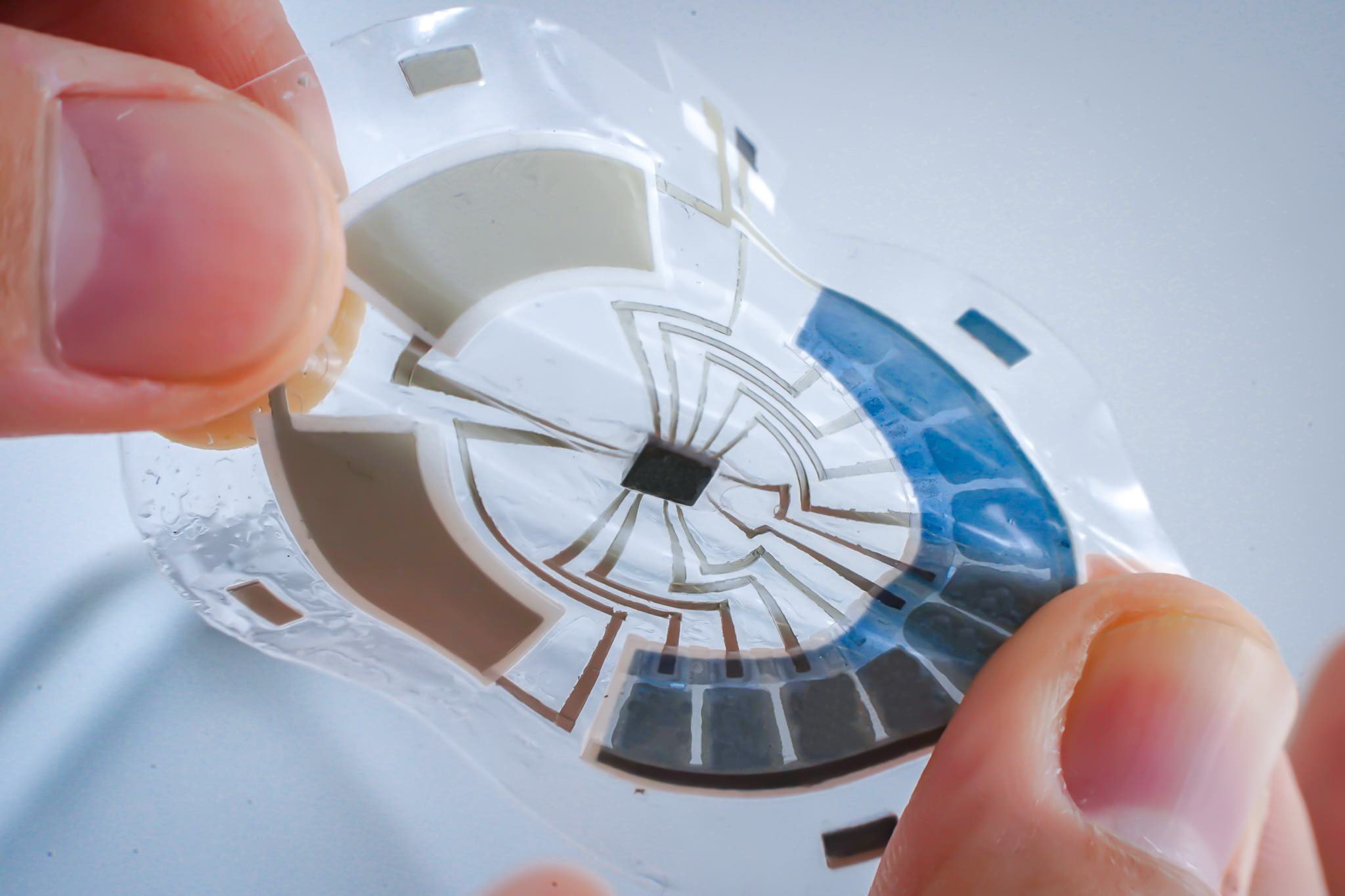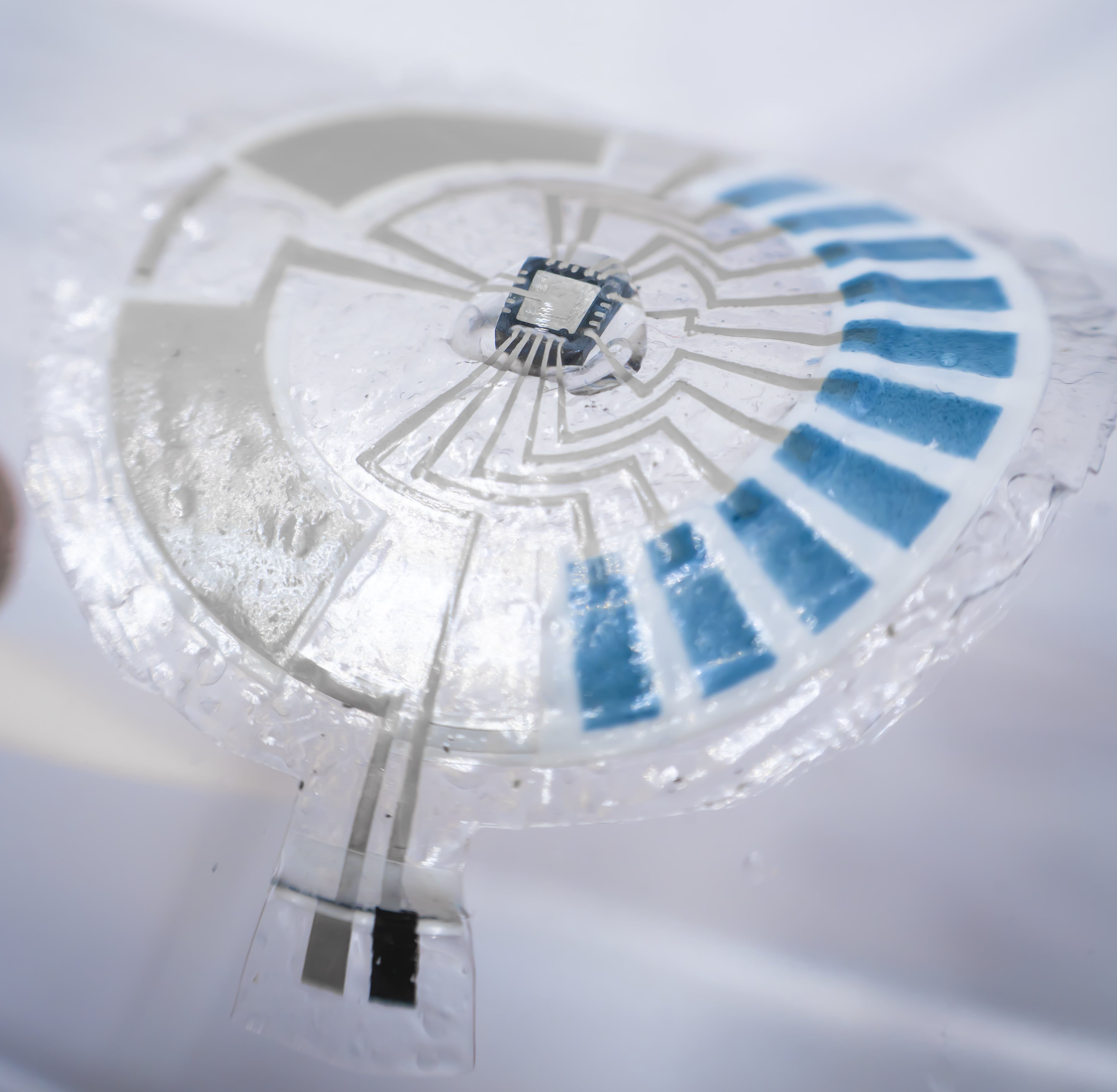| Oct 08, 2022 |
Standalone sweat sensor provides immediate readout
(Nanowerk News) Engineers at the University of California San Diego have developed a thin, flexible and stretchy sweat sensor that can show the level of glucose, lactate, sodium, or pH of your sweat, at the press of a finger. It is the first standalone wearable device that allows the sensor to operate independently – without any wired or wireless connection to external devices – to directly visualize the result of the measurement.
|
|
This fully-integrated soft skin patch is reported in a paper in Nature Electronics ("A stretchable epidermal sweat sensing platform with an integrated printed battery and electrochromic display"), reflecting the new state-of-the-art of wearable sensors.
|
 |
| The patch can be stretched 20% repeatedly without affecting its performance. (Image: Lu Yin, Jacobs School of Engineering, UC San Diego)
|
|
The unique design of this small disk-shaped patch includes all the essential components that are required for wearable sensors: two integrated batteries, a microcontroller, sensors, the circuit, and a stretchable display. This covers all functionalities essential for operating a wearable sensor, from powering up to showing the user the results.
|
|
“We are trying to address the issue of practicality in wearable technologies,” said co-first author Lu Yin, a nanoengineering postdoctoral researcher at the UC San Diego Jacobs School of Engineering. “We have seen so many inventions of wearable sensors with great novelty but with limited practicality.”
|
An assembly of engineering endeavors
|
|
All the components and interconnections, except the microcontroller, are fabricated using customized elastomeric inks, which can be printed using low-cost and high-throughput screen printing onto stretchable polymer sheets.
|
|
“This requires every trade of engineering to come together,” said Yin. “You need experts in sensors, displays, batteries, circuit designs, firmware engineering, to get every module within this small patch to work. The integration of them also requires the knowledge in electrochemistry, electronic engineering, and material science, to ensure that all parts remain stretchable, reliable, and compatible to work seamlessly together as a system.”
|
|
The fabrication of the device involves the formulation of nine types of different stretchable inks, which were used to print the batteries, circuits, display panel, and sensors. The device is printed layer-by-layer onto stretchable polymer sheets and then assembled with hydrogels and microcontroller chips into the complete device. Each ink was optimized to ensure its compatibility with other layers while balancing its electrical, chemical, and mechanical performance.
|
|
In the study, the researchers have stress-tested each component of the system, making sure that the display, sensors, and batteries can be stretched for up to 20% over 1500 cycles with little to no effects on their performance. The batteries were also packed with enough power to make sure the patch can last over a week of non-stop usage.
|
|
To showcase the wide application possibilities of this patch, the researchers demonstrated four different types of sensors that work with this patch: a sodium sensor, a pH sensor, a lactate sensor, and a glucose sensor. Each sensor type measured different metrics in the sweat during exercise.
|
|
“Adding the flexible display and stretchable battery has a tremendous impact toward practical epidermal microscale sensing platforms," said UC San Diego nanoengineering professor Joseph Wang. He is a senior author on the new paper and co-director of the UC San Diego Center for Wearable Sensors.
|
|
The research team also included a fluidic channel made of adhesives, to adhere the patch to the skin and guide the sweat to flow across the sensor. A small switch mechanism was included on the patch, and the concentration of the chemical being measured will instantly show on the display as soon as the user presses the switch.
|
Rapid visualization on a wearable screen
|
|
To visualize the data from the sensors, the authors designed a special type of non-light-emitting display called electrochromic display. The electrochromic display technology uses materials that change color upon applying an electrical pulse, which has very low power consumption.
|
 |
| The display can rapidly change color to visualize the sweat lactate concentration. (Image: Lu Yin, Jacobs School of Engineering, UC San Diego)
|
|
“It is a relatively new technology which you see now in color-changing windows in buildings and on some airplanes. But the challenge is to make it compatible with the soft, stretchable form factor in the rest of the patch,” said Yin. “Typical electrochromic displays require transparent glass panels with a conductive but brittle coating, which does not work for our device.”
|
|
Instead, the researchers turned to a special polymer called PEDOT:PSS, which is both conductive and has electrochromic properties. The polymer changes from light sky blue to dark navy blue when applying a negative voltage, and turns back when applying a positive voltage. By tuning the ink formulation with PEDOT:PSS, we can make it both printable and stretchable.”
|
|
The researchers designed a display panel composed of 10 individual pixels, which is programmed to display the concentration of the chemicals by turning on different numbers of the pixel. After optimizing the operation condition of the display, each pixel can be turned on and off reversibly over 10,000 cycles, more than sufficient for its week-long operation. The pixels only take 500 ms to change color, during which time they consume on average 80 microwatts of power. As it requires no power to maintain the displayed result, the display is very energy efficient for its application.
|
Next Steps
|
|
Currently, the patch is not rechargeable and works with one sensor at a time. The team aims to develop a more advanced version of the integrated sensor, which allows the battery to be rechargeable, and can even harvest energy from the body, to extend the lifetime of the wearable patch. Skin-worn multiplexed sensors – measuring simultaneously multiple biomarkers - can also be added to the system to provide a comprehensive view of the physiological status of the user.
|
|
“This is a big step forward in developing wearable electronics that are practical and user-friendly, but this is just a start,” Yin commented.
|


